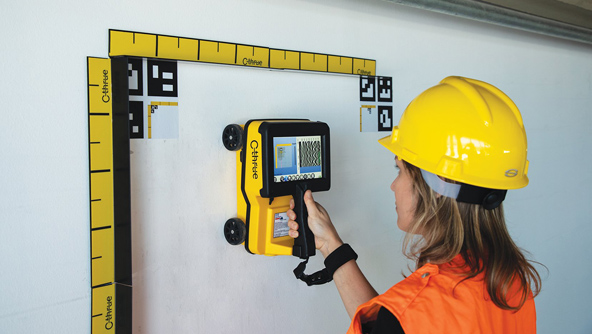Advanced Concrete Scanning Techniques: Guaranteeing Architectural Integrity
Elevate Your Construction Process With the Strategic Insights of Concrete Scanning for Enhanced Productivity
In the realm of modern building and construction practices, the pursuit for effectiveness and accuracy is paramount. Accepting ingenious modern technologies has become a foundation for accomplishing these purposes. One such technology that has actually changed the building and construction market is concrete scanning. By utilizing the strategic insights given by concrete scanning, construction professionals can open a realm of boosted performance and streamlined processes. The effects of integrating concrete scanning go much beyond surface-level benefits, supplying a profound effect on project end results.

Benefits of Concrete Scanning
Enhancing task performance and safety and security, concrete scanning uses a non-destructive technique for spotting concealed objects within concrete frameworks. By utilizing modern technologies such as ground-penetrating radar (GPR) and concrete x-ray imaging, building groups can precisely locate rebar, post-tension cables, electric channels, and various other obstructions prior to boring, reducing, or coring into concrete.
The advantages of concrete scanning are numerous. Building sites can be complex atmospheres, and understanding what lies underneath the surface area can protect against injuries and crashes.
Moreover, concrete scanning promotes overall project effectiveness by simplifying operations and stopping rework. By identifying prospective concerns early on, groups can readjust their strategies proactively, conserving time and resources in the long run. Basically, the fostering of concrete scanning modern technologies is a critical investment that pays dividends in regards to safety, cost-effectiveness, and performance.
Modern Technology Combination for Efficiency
Concrete scanning's capacity to enhance process and boost project efficiency can be more enhanced through tactical assimilation of innovative technologies. By including Building Details Modeling (BIM) software application right into concrete scanning processes, building and construction groups can achieve a higher level of precision and control. BIM permits the production of 3D models that offer comprehensive understandings into the job, making it possible for much better decision-making and minimizing the likelihood of errors. Additionally, the combination of Enhanced Truth (AR) technology with concrete scanning can enhance on-site visualization, permitting project supervisors and workers to overlay electronic info onto the physical atmosphere in actual time. This can facilitate much more specific positioning of aspects and boost interaction amongst staff member. The use of drones for airborne surveys in conjunction with concrete scanning can expedite information collection and analysis, allowing faster decision-making and progression monitoring. Generally, the tactical combination of these modern technologies can substantially increase efficiency and performance in construction tasks.
Avoiding Pricey Errors
Just how can precise focus to detail throughout concrete scanning procedures help building and construction teams in stopping costly mistakes? By utilizing sophisticated scanning modern technologies such as Ground Penetrating Radar (GPR) and electromagnetic induction, building and construction teams can precisely identify rebar, utilities, spaces, and other obstructions within concrete frameworks. Additionally, concrete scanning aids in ensuring structural stability by identifying weaknesses or flaws in the concrete very early on, permitting for timely repair services and modifications.
Enhancing Task Administration
Meticulous attention to detail during concrete scanning refines not just aids in staying clear of costly mistakes but likewise lays a strong foundation for efficient job monitoring in building and construction undertakings. By incorporating concrete scanning technology into project administration approaches, construction teams can enhance operations, enhance interaction, and ensure that projects remain on track.
Concrete scanning gives beneficial understandings right into the architectural stability of existing aspects, enabling job supervisors to make informed decisions concerning design modifications or construction sequences. This proactive approach minimizes the danger of unanticipated hold-ups or revamp, inevitably conserving time and resources. Furthermore, the data acquired from concrete scanning can be integrated into Structure Details Modeling (BIM) platforms, making it possible for real-time collaboration and control amongst numerous stakeholders.
In addition, concrete scanning assists project managers determine potential dangers or barriers before they escalate right into larger issues, advertising a more secure workplace for all involved. With enhanced visibility and precision supplied by concrete scanning technology, task managers can effectively intend, keep an eye on, and perform building and construction jobs with greater efficiency and self-confidence.
Taking Full Advantage Of Efficiency
One essential aspect of making the most of productivity is through the adoption of concrete scanning modern check out here technology. By using ground-penetrating radar (GPR) and various other scanning techniques, construction teams can accurately find rebar, avenues, and various other subsurface aspects, decreasing the threat of expensive errors and delays throughout excavation and exploration.
Furthermore, accepting Structure Info Modeling (BIM) software can substantially boost productivity by producing detailed 3D designs that improve project visualization and sychronisation among various professions. BIM permits much better clash detection, making it possible for concerns to be determined and dealt with prior to construction even starts, conserving time and sources in the future.
Implementing a lean building approach, which focuses on eliminating waste and optimizing efficiency across all job stages, is one more efficient approach for making the most visite site of productivity. By fostering collaboration, interaction, and continuous improvement, building and construction groups can work more cohesively in the direction of accomplishing task objectives in a structured and efficient manner.
Verdict
In conclusion, the tactical implementation of concrete scanning in the building and construction procedure provides various advantages, consisting of raised efficiency, expense savings, boosted project administration, and boosted performance. By integrating this modern technology, building and construction groups can stay clear of costly errors, image source streamline their operations, and maximize their total project result. Concrete scanning is an important tool that can boost the building process and lead to more successful and rewarding outcomes.
